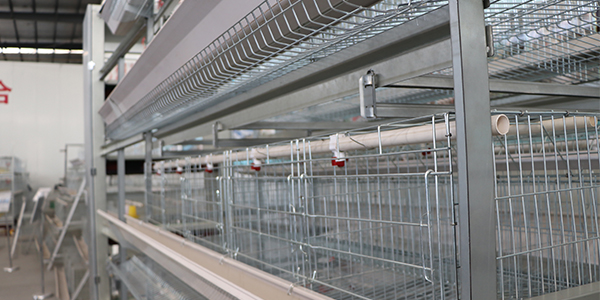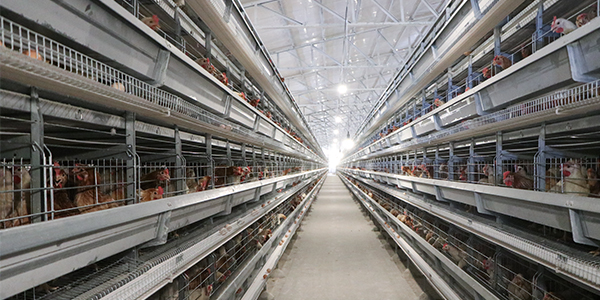Keep the chickens in the coop
Jul 12, 2019
Farmers who use eggs to raise chickens are most concerned about the egg production rate of the flock of chickens, which is related to the economic benefits of farmers. However, how to achieve high-energy production of the flock of laying hens in this process? Here are some points that farmers should pay attention to when raising chickens in cages.
Pay attention to disinfection and epidemic prevention
As the temperature warms up, various pathogenic microorganisms begin to multiply in large Numbers. In addition, the physical strength of laying hens raised in cages during the laying period is consumed, which leads to a decline in physique, poor resistance and easy infection of bacteria. Therefore, one of the key points of laying hen breeding and management is to do a good job of disinfection and disease prevention. Optional in sunny days, the inside and outside environment of the chicken cage and chicken house for thorough cleaning, disinfection, can be in the space and chicken body spray a certain concentration and dose of disinfectant, in order to kill air and chicken body bacteria and viruses. At the same time, keep drinking water clean and conduct regular antibody monitoring. In spring, the time interval of surveillance should be shortened and immunization should be supplemented according to the surveillance results.
Timely supplementary lighting
Light is an important factor affecting the production of layer, which plays an important role in the maturation, ovulation and egg production of layer. Artificial supplemental light is needed to keep the chickens' daily exposure at 14 to 16 hours, increasing it to 17 hours after reaching 60 weeks of age. Inside general chicken house every square metre has electric lamp 3, 5 watts, the lamp is apart from the ground 2 meters or so. The lamp is apart from is 3 meters, want to open the lamp compensatory illumination in time when the light inside chicken house is darker, the requirement often wipes bulb, prevent dirt too thick make illuminative intensity abate.
Ensure nutrition supply
Layers have a high demand for energy when the temperature is low in winter, and the supply of energy feed should be appropriately reduced after the spring warming, otherwise the body condition of layers will be too fat, leading to a decline in egg production rate, so the proportion of corn and other grains in the feed of layers should be appropriately reduced. Egg laying hens in the period of protein requirements increase, generally when the egg yield reaches 50%, the protein content in the feed is required to be 15.5%, after the egg yield increases by 10%, the protein content in the feed should be increased by 0.5%, but more than 18.5%, the main source of protein is fish meal, bean cakes and so on.
With the improvement of rate, the chicken for minerals and vitamins, particularly Pei strives for the increase of calcium, phosphorus, if lack of calcium and phosphorus content in laying hens feed, can lead to egg laying hens eggs with soft shells, shell, or the shell of poor quality, easily damaged, can appear even chickens pecking eggs, so in laying hens egg production many times, can raise the content of calcium, phosphorus in feed. Feed salt should also be added to chicken feed and increase the proportion of all kinds of green vegetables to improve the appetite of layers and promote digestion.
Pay attention to the environment of the coop
Control the environment inside the cage chicken coop, in which the temperature is the main factor, usually the suitable temperature of the layer is 12 -- 20℃, 13 -- 17℃ high egg production rate. In the case of variable spring temperature, especially in the evening temperature is lower, in early spring cold weather, can still be used in the indoor furnace or hot fan to warm, and to repair the doors and Windows, to avoid air leakage. At the same time, control the breeding density of chicken group, to do a good job of ventilation regularly, can not reduce ventilation with the spring weather is colder, otherwise the harmful gas such as carbon dioxide, hydrogen sulfide, ammonia in the house is not discharged in time, will induce chicken group to suffer from diseases such as respiratory tract.
Strengthen feeding management
In feeding and management, the chickens should be guaranteed to receive high-quality, nutritionally comprehensive and balanced, fresh and adequate feed. Layer is easy to produce stress response in the spring, so in feeding, adding water, egg picking, disinfection and other work should be in accordance with a certain time and sequence of operation.
Summer temperature is higher, but also timely according to the weather changes to do prevention, when cold weather, but also do a good job in the insulation of the chicken coop and coop, can increase the feed times and the energy level in the feed. Do when temperature is high, open a window ventilated; When the temperature is low, close the window to keep warm; Open the window when there is no wind, and close the window when there is wind, so as to avoid respiratory diseases of laying hens and improve the egg production rate.
Pre:What equipment is used to raise chicken more appropriate
Next:Chicken equipment to do a good health management


